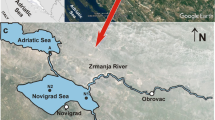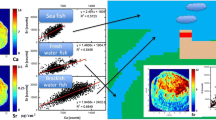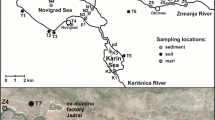Abstract
Heavy metal concentrations were studied in the scales of recent and subrecent (2–25 years old) fish buried in the oxbow lake sediments of the Morava River. The samples were taken from two cores up to 4-m deep and analysed using laser ablation inductively coupled plasma mass spectrometry (LA-ICP-MS) and an electron microprobe analysis (EMPA). The results were compared with heavy metal concentrations of bulk samples of the embedding sediment. The study has revealed substantial differences in heavy metal contents existing between the recent and subrecent fish scales documenting an extreme rapidity of the diagenesis/fossilization processes. The most apparent features of the early fossilization include the quick loss of the mucous envelope, collagen and magnesium and an enormous increase in the heavy metal concentrations in particular iron, which is connected with a colour change. The variations in heavy metal contents in fish scales within a sample are attributed to variations in heavy metal content in the environment and variable amounts of organic matter in the embedding sediment. In contrast to the contamination of the embedding sediment, no general increase in heavy metal concentrations in fish scales was observed down to the cores. It is inferred that the rapid sorption stabilizes the biologic hydroxyapatite of the fish scales, which thus rapidly attain a thermodynamic equilibrium with the embedding water-saturated sediment. The results show that the processes of sorption, fossilization and stabilization of hydroxyapatite can act very quickly over a time scale of several years and represent thus a great advantage in the preservation of the original signals of the ancient environments.





Similar content being viewed by others
References
Admassu W, Breese T (1999) Feasibility of using natural fishbone apatite as a substitute for hydroxyapatite in remediating aqueous heavy metals. J Hazar Mater 69(2):187–196
Bábek O, Hilscherová K, Nehyba S, Zeman J, Famera M, Francu J, Holoubek I, Machát J, Klánová J (2008) Contamination history of suspended river sediments accumulated in oxbow lake for the last 25 years; River Morava (Danube Catchment Area), Czech Republic. J Soils Sediments (in print). doi:10.1007/s11368-008-0002-8
Baturin GN (2001) Uranium and Thorium in phosphatic bone debris from the ocean bottom. Lithol Miner Resour 36(2):99–108
Baturin GN, Dubinchuk VT (2003) On the composition of phosphatized bones in recent sediments. Litol Polezn Iskop 3:313–323
Bostick WD, Stevenson RJ, Harris LA, Peery D, Hall JR, Shoemaker JL, Jarabek RJ, Munday EB (2003) Use of apatite for chemical stabilization of subsurface contaminants. Technical Report. Submitted to US Department of Energy, National Energy Technology Laboratory
Carvalho ML, Marques A (2008) Diagenesis evaluation in middle ages human bones using EDXRF. X-Ray Spectrom 37:32–36
Chen X, Wright JV, Conca JL, Prurung LM (1997) Effects of pH on heavy metal sorption on mineral apatite, Environ. Sci Technol 31(3):624–631
Coutant CC, Chen CH (1993) Strontium microstructure in scales of freshwater and estuarine striped bass (Morone saxatilis) detected by laser ablation mass spectrometry. Can J Fish Aquat Sci 50:1318–1323
Farrell AP, Hodaly AH, Wang S (2000) Metal analysis of scales taken from Arctic grayling. Arch Environ Contam Toxicol 39(4):515–522
Fouda MM (1979) Studies on scale structure in the common goby Pomatoschistus microps Kroyer. J Fish Biol 15:173–183
Hamada M, Mikuni A (1990) X-ray diffraction analysis of sardine scale ash. Nippon Suisan Gakkai Shi 56:947–951
Hilscherová K, Dusek L, Kubik V, Cupr P, Hofman J, Klánová J, Holoubek I (2007) Redistribution of organic pollutants in river sediments and alluvial soils related to major floods. J Soils Sediments 7:167–177
Labs Hochstein J (2005) Quantification of the extent of diagenesis in biogenic apatite of Cenozoic shark Centra. PhD. University of Florida, USA
Johnsson K (1997) Chemical dating of bones based on diagenetic changes in bone apatite. J Archaeol Sci 24:431–437
Kang D, Amarasiriwardena D, Goodman AH (2004) Application of laser ablation–inductively coupled plasma-mass spectrometry (LA–ICP–MS) to investigate trace metal spatial distributions in human tooth enamel and dentine growth layers and pulp. Anal Bioanal Chem 378:1608–1615
Lower SK, Maurice PA, Traina SJ (1998a) Simultaneous dissolution of hydroxylapatite and precipitation of hydroxylpyromorphite: direct evidence of homogeneous nucleation. Geochim Cosmochim Acta 62:1773–1780
Lower SK, Maurice PA, Traina SJ, Carlson EH (1998b) Aqueous Pb sorption by hydroxylapatite: applications of atomic force microscopy to dissolution, nucleation, and growth studies. Am Mineral 83:147–158
Ma QY, Traina SJ, Logan TJ, Ryan JA (1993) In situ lead immobilization by apatite. Environ Sci Technol 27:1803–1810
Ma QY, Traina SJ, Logan TJ, Ryan JA (1994) Effects of Al, Cd, Cu, Fe(II), Ni, and Zn on Pb immobilization by hydroxyapatite. Environ Sci Technol 28:1219–1228
Martin WA, Larson SL, Felt DR, Wright J, Griggs CS, Thompson M, Conca JL, Nestler CC (2008) The effect or organics on lead sorption on to Apatite II.Tm. Appl Geochem 23(1):34–43
Muhlfeld C, Marotz B, Thorrold S (2005) Geochemical signatures in scales record stream of origin in westslope cutthroat trout. Trans Am Fish Soc 134:945–959
Nemliher JG, Baturin GN, Kallaste TE, Murdmaa IO (2004) Transformation of hydroxyapatite of Bone Phosphate from the Ocean Bottom during Fossilization. Lithol Miner Res 39:468–479
Nriagu JO (1984) Formation and stability of base metal phosphates in soils and sediments. In: Nriagu JO, Moore PB (eds) Phosphate minerals. Springer, London, pp 318–329
Okazaki M, Takahashi J, Kimura H (1985) Iron uptake of hydroxyapatite. J Osaka Univ Dent Sch 25:17–24
Oosten J van (1957) Skin and scales. In: Brown ME (ed) The physiology of fishes, vol 1, Academic Press, New York, pp 207–244
Pate FD, Hutton JT, Norrish K (1989) Ionic exchange between soil solution and bone: toward a predictive model. Appl Geochem 4:303–316
Pouchou JL, Pichoir F (1985) “PAP”(φ–ρ–Z) procedure for improved quantitative microanalysis. In: Armstrong JT(ed) Microbeam analysis, San Francisco Press, pp 104–106
Reiche I, Favre-Quattropani L, Vignaud C, Bocherens H, Charlet L, Menu M (2003) A multi-analytical study of bone diagenesis: the Neolithic site of Bercy (Paris, France). Meas Sci Technol 14(9):1608–1619
Seshaya RV, Ambujarai P, Kalyani M (1963) Amino acid composition of ichthylepidin from fish scales. In: Ramachandran GN (ed) Aspects of protein structure. Academic Press, London, pp 343–356
Shashkova IL, Ratko AI, Kitikova NV (1999) Removal of heavy metal ions from aqueous solutions by alkaline-earth metal phosphates. Colloids Surf A Physicochem Eng Asp 160:207–215
Smiciklas I, Onjia A, Raicević S, Janaćković D, Mitrić M (2008) Factors influencing the removal of divalent cations by hydroxyapatite. J Hazard Mater 152(2):876–884
Sparks NH, Motta PJ, Shellis RP, Wade VJ, Mann S (1990) An analytical electron microscopy study of iron-rich teeth from the butterflyfish (Chaetodon ornatissimus). J Exp Biol 151:371–385
Sutter B, Ming DW, Clearfield A, Hossnerc LR (2003) Mineralogical and chemical characterization of iron-, manganese-, and copper-containing synthetic hydroxyapatites. Soil Sci Soc Am J 67:1935–1942
Suzuki T, Hatsushika T, Miyake M (1982) Synthetic hydroxyapatites as inorganic cation exchangers: 2. J Chem Soc Faraday Trans I 78:3605–3611
Lee-Thorp JA (2000) Preservation of biogenic carbon isotope signals in Plio-Pleistocene bone and tooth mineral. In: Ambrose SH, Katzenberg MA (eds) Biogeochemical approaches to paleodietary analysis. Kluwer Academic/Plenum Press, New York, pp 89–115
Wakamura M, Kandori K, Ishikawa T (2000) Surface structure and composition of calcium hydroxyapatites substituted with Al(III), La(III) and Fe(III) ions. Colloids Surf A Physicochem Eng Asp 164:297–305
Wells BK, Thorrold SR, Jones CM (2000) Geographic variation in trace element composition of juvenile weakfish scales. Trans Am Fish Soc 129:889–900
Wells BK, Rieman BE, Clayton JL, Horan DL (2003a) Relationships between water, otolith, and scale chemistries of westslope cutthroat trout from the Coeur d’Alene River, Idaho: the potential application of hard-part chemistry to describe movements in fresh water. Trans Am Fish Soc 132:409–424
Wells BK, Thorrold SR, Jones CM (2003b) Stability of elemental signatures in the scales of spawning weakfish, Cynoscion regalis. Can J Fish Aquat Sci 60:361–369
Wright J (1990) Conodont apatite: structure and geochemistry. In: Carter J (ed) Skeletal biomineralization: patterns, processes and evolutionary trends. Van Nostrand Reinhold, New York, pp 445–459
Xu H, Schwartz FW (1994) Lead immobilization by hydroxyapatite in aqueous solutions. J Contam Hydrol 15(3):187–206
Yasukawa A, Yokoyama T, Kandori K, Ishikawa T (2002) Ion-exchangeability of calcium hydroxyapatite and magnesium-calcium hydroxyapatite solid solution. Nippon Kagakkai Koen Yokoshu 81(1):392
Yasukawa A, Yokoyama T, Kandori K, Ishikawa T (2007) Reaction of calcium hydroxyapatite with Cd2+ and Pb2+ ions. Colloids Surf A Physicochem Eng Asp 299:203–208
Zylberberg L (2004) New data on bone matrix and its proteins. C R Palevol 3:591–604
Zylberberg L, Nicols G (1982) Ultrastructure of scales in a teleost (Carassius auratus L.) after use of rapid freeze-fixation and freeze-substitution. Cell Tissue Res 223:349–367
Acknowledgments
This study was supported by the project MSM0021622412 (INCHEMBIOL). The authors would like to express their thanks to M. Kosík, and Jiri Horsak, the head of the Moravian fisherman organization in Stare Mesto for their field and logistic assistance.
Author information
Authors and Affiliations
Corresponding author
Rights and permissions
About this article
Cite this article
Holá, M., Kalvoda, J., Bábek, O. et al. LA-ICP-MS heavy metal analyses of fish scales from sediments of the Oxbow Lake Certak of the Morava River (Czech Republic). Environ Geol 58, 141–151 (2009). https://doi.org/10.1007/s00254-008-1501-z
Received:
Accepted:
Published:
Issue Date:
DOI: https://doi.org/10.1007/s00254-008-1501-z




